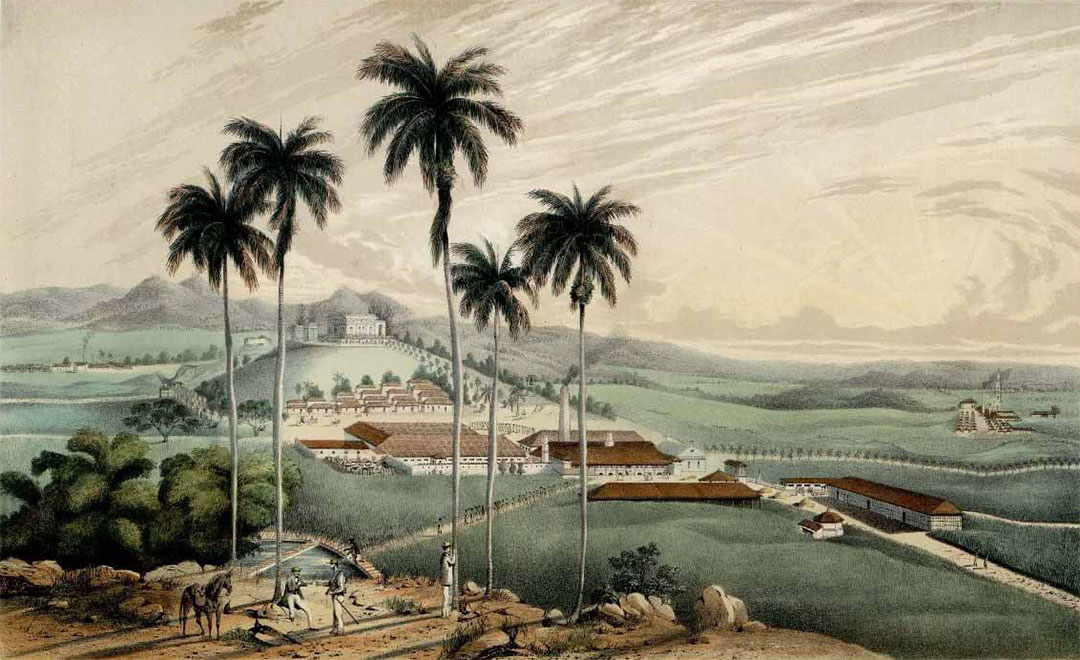
MIGUEL BARNET
Biografía de
un cimarrón
Biography of a
Runaway Slave
"La
naturaleza es todo. Hasta lo que no se ve." (15)
“Nature is everything. Even what you can’t see.” (17)
 Eduardo Laplante, Ingenio Buena Vista, Cuba, 1857
Eduardo Laplante, Ingenio Buena Vista, Cuba, 1857 The 1966 text Biografía
de un cimarrón is a condensation of the interviews that ethnographer Miguel
Barnet conducted with the 104-year-old Esteban Montejo, who escaped slavery to
live in the mountains of central Cuba as a young man and subsequently fought in
the Cuban War of Independence. As one of only two extant Cuban slave narratives
(the other being Juan Francisco Manzano’s Autobiografía de un esclavo), Biografía offers a historically significant glimpse into life on a nineteenth-century
sugar plantation from the perspective of a man born into slavery.
Yet sugar is far from the only plant that features in the work. Montejo develops an extensive knowledge of the diverse vegetation of the monte beyond the limits of the cane fields, and it is through this ecological literacy that he manages to survive in the wilderness until emancipation.
Yet sugar is far from the only plant that features in the work. Montejo develops an extensive knowledge of the diverse vegetation of the monte beyond the limits of the cane fields, and it is through this ecological literacy that he manages to survive in the wilderness until emancipation.
Plants feature in almost every aspect of Montejo’s world. From the holy herbs of the Afro-Cuban religions of Palo Monte and Regla de Ochá, to the gardens (called conucos) where the enslaved people cultivated vegetables to survive, to the architectural techniques of the mambises in the Cuban War of Independence, plants were essential ingredients in daily life.
It bears note that the accuracy and genre of the work have been hotly debated. Barnet himself described it as a novela testimonio, or testimonial novel, suggesting that it draws upon ethnographic methods and the techniques of fiction writing alike. What is clear is that Montejo’s oral testimony is filtered through the perspective of the twentieth-century ethnographer to some extent, so Biografía must be read as a polyphonic negotiation between subject and interviewer.
It bears note that the accuracy and genre of the work have been hotly debated. Barnet himself described it as a novela testimonio, or testimonial novel, suggesting that it draws upon ethnographic methods and the techniques of fiction writing alike. What is clear is that Montejo’s oral testimony is filtered through the perspective of the twentieth-century ethnographer to some extent, so Biografía must be read as a polyphonic negotiation between subject and interviewer.
World origins of plant biodiversity in Miguel Barnet’s Biografía de un cimarrón by raw number of species
Arrows highlight the diverse origins of the flora.
Click on a realm to
explore the plants.
Click again to deselect.
World origins of plant biodiversity in Miguel Barnet’s Biografía de un cimarrón weighted by number of mentions
Arrows show
the five most mentioned plants.
Click on a realm to
explore the plants.
Click again to deselect.
Percentage of species native to Cuba in Miguel Barnet’s Biografía de un cimarrón
Native species are mentioned proportionally less than non-native species.
Reflections
The greatest variety of species in the text come from the Neotropical realm, consisting mostly of the native Cuban plants Montejo uses to survive in the wilderness.
Frequently, he substitutes native plants for cash crops in his life on the monte. He makes a coffee drink from guanina achicharrada, or coffee senna, and he smokes the leaves of the macagua, or macaw tree, instead of tobacco.
Frequently, he substitutes native plants for cash crops in his life on the monte. He makes a coffee drink from guanina achicharrada, or coffee senna, and he smokes the leaves of the macagua, or macaw tree, instead of tobacco.
Yet the Cuba he describes is a cosmopolitan landscape, its vegetation reflecting the flows of human immigrants from Spain, Africa, and China. Imports like opium, sesame, and grapes acquire new cultural meanings in the context of Cuban society.
Plants from the Neotropical realm are mentioned the most, followed by the Indomalayan and Austrolasian realms where cash crops like sugarcane and coconut originated.
Plants from the Neotropical realm are mentioned the most, followed by the Indomalayan and Austrolasian realms where cash crops like sugarcane and coconut originated.
Learn about the plants in the text that come from each of the world’s biogeographic realms:
Afrotropical realm
Australasian realm
Indomalayan realm
Nearctic realm
Neotropical realm
Palearctic realm

Image credits:
Eduardo Laplante, Ingenio Buena-Vista. Propiedad Del Sr. D. Justo G. Cantero. Departamento Occidental, Jurisdicción Del Trinidad, Partido de Río de Ay., 1857, lithographic print, hand colored, 1857, Los ingenios. Colección de vistas de los principales ingenios de azúcar. Havana, Litografía de L. Marquier, https://commons.wikimedia.org/wiki/File:Ingenio_Buena-Vista_1857.jpg.
Tomás Sánchez, Autorretrato En Tarde Rosa, 1994, Acrylic on linen, 1994,
https://www.thisiscolossal.com/2020/03/tomas-sanchez-landscape-paintings/.
Tomás Sánchez, Orilla y Cielo Gris, 1995, Acrylic on canvas, 1995,
https://www.thisiscolossal.com/2020/03/tomas-sanchez-landscape-paintings/.
Text editions:
Esteban Montejo and Miguel Barnet, Biografía de Un Cimarrón, 223 p. (La Habana: Editorial Letras Cubanas, 1980), catalog.hathitrust.org/Record/005222640.
Esteban Montejo, Biography of a Runaway Slave, ed. Miguel Barnet, trans. W. Nick Hill (Connecticut: Curbstone Press, 1994).
Eduardo Laplante, Ingenio Buena-Vista. Propiedad Del Sr. D. Justo G. Cantero. Departamento Occidental, Jurisdicción Del Trinidad, Partido de Río de Ay., 1857, lithographic print, hand colored, 1857, Los ingenios. Colección de vistas de los principales ingenios de azúcar. Havana, Litografía de L. Marquier, https://commons.wikimedia.org/wiki/File:Ingenio_Buena-Vista_1857.jpg.
Tomás Sánchez, Autorretrato En Tarde Rosa, 1994, Acrylic on linen, 1994,
https://www.thisiscolossal.com/2020/03/tomas-sanchez-landscape-paintings/.
Tomás Sánchez, Orilla y Cielo Gris, 1995, Acrylic on canvas, 1995,
https://www.thisiscolossal.com/2020/03/tomas-sanchez-landscape-paintings/.
Text editions:
Esteban Montejo and Miguel Barnet, Biografía de Un Cimarrón, 223 p. (La Habana: Editorial Letras Cubanas, 1980), catalog.hathitrust.org/Record/005222640.
Esteban Montejo, Biography of a Runaway Slave, ed. Miguel Barnet, trans. W. Nick Hill (Connecticut: Curbstone Press, 1994).